13+ Memo in Google Docs Examples
In order to make sure that everyone in the company can retain the information that has been discussed or to give them the information that they should know about, a unified method of communication should be used. This will greatly help in maintaining harmony and peace within the company since information is shared transparently and succinctly.
With this regard, a memo or memorandum is document used to communicate policies, procedures, or related official business. It also helps those in charge in the company or organization to impose rules and policies within their jurisdiction. And since it expresses the finality in the decisions, it also encourages those concerned for their total compliance.
Elements of a Memo
Since a memo is a formal or official document used to share information to those concerned, it should be detailed and complete. To help you create a good and effective memo, here are the essential elements that you should include:
1. Title: On the topmost part of the memo it should indicate a title describing what it is for or what the contents are about. For example, when you the indicated memo title is Meeting Minutes Memo it tells the reader that the contents he/she is about to read has everything to do with the minutes of a meeting.
2. Heading: The heading of the memo contains all pertinent information about who it is from and who it is for. It should provide information about the following:
- To: Name/s who the memo is intended for; who are those concerned with the memo
- Cc: Name of who gets a copy of the memo
- From: Complete name, position or designation, office or department of the writer
- Date: Date when the memo is written
- Subject: Gist of the memo
4. Opening: The opening should provide more context with regards to the subject being discussed. It should briefly explain the purpose why there was a need to write and distribute the memo. A complete overview about the event, circumstance, or background of the problem.
5. Body: The body of the memo should provide supporting details with what has been explained in the opening. You should provide supporting details such as facts, statistics, hypotheses, and so on. If necessary, you can also provide charts, graphs, and other illustrations so that there is a clear representation of the data and information you are conveying.
6. Summary: You need to make sure that your readers are able to understand all the information you have discussed in the memo; therefore, you should provide a clear summary. The summary should be able to briefly explain what has been discussed in the previous parts of the memo; only focus in discussing the most important topic.
7. Closing: The closing should provide a call to action as to encourage everyone to their responsibilities or parts in solving the issues or problems. You should also specify how those actions can be of benefit for everyone. You may also see student memo.
13+ Memo Templates
Sample Memo Example
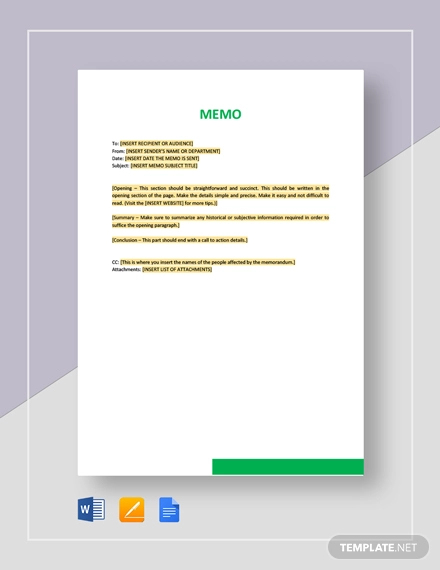
Audit Memo Example
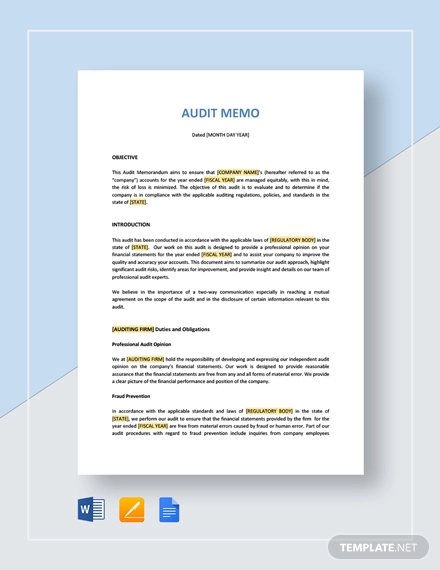
Internal Audit Memo Example
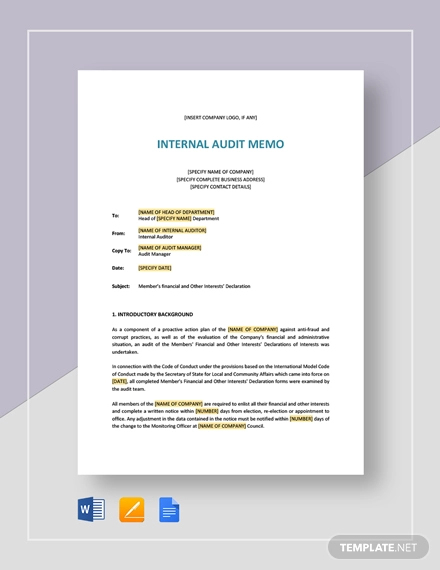
Meeting Memo
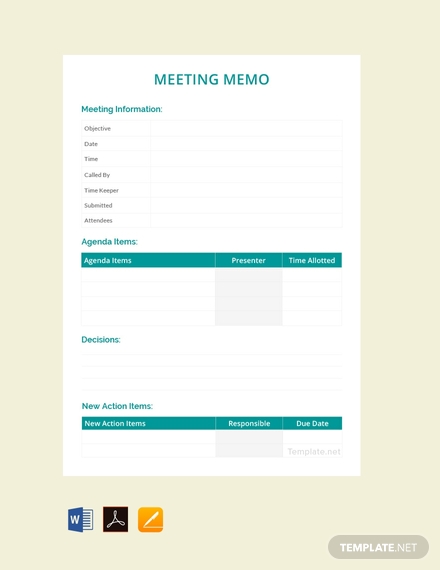
Staff Meeting Memo

Internal Memo to Employees
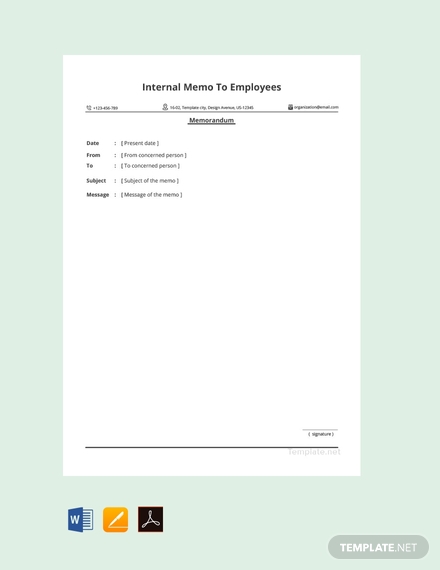
Internal Memo Template
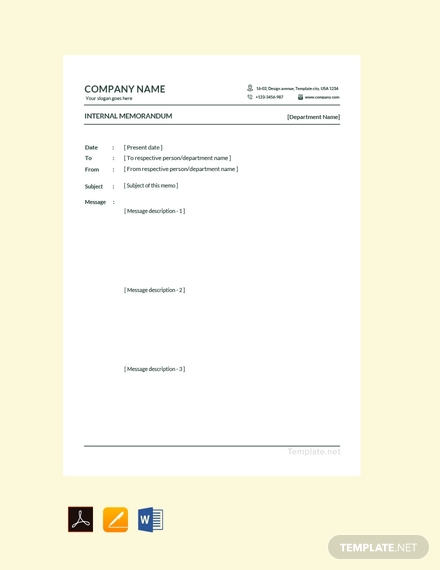
Business Meeting Memo
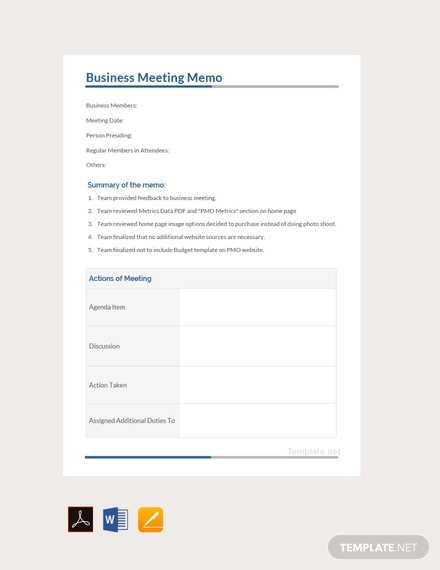
Blank Meeting Memo
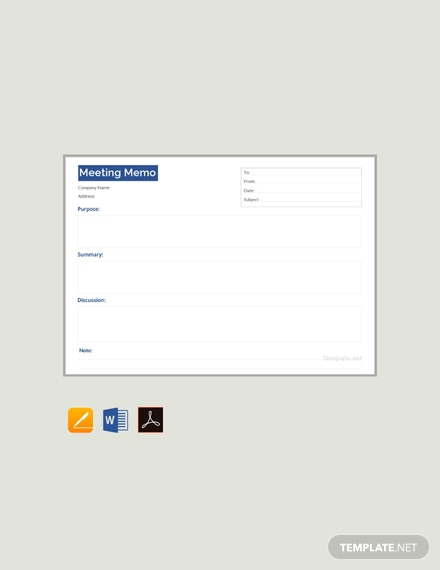
Board Meeting Memo
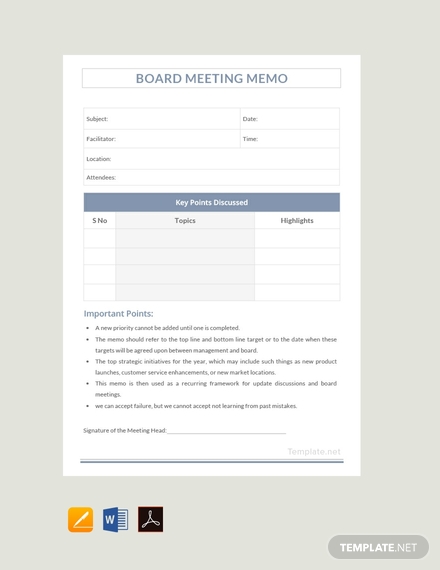
Formal Internal Memo
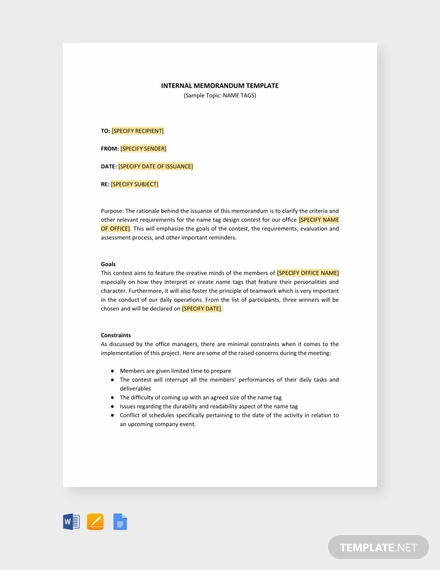
Debit Memo Template
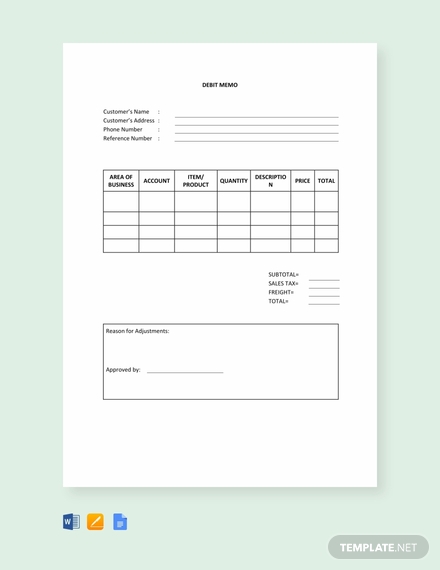
Internal Memo Format
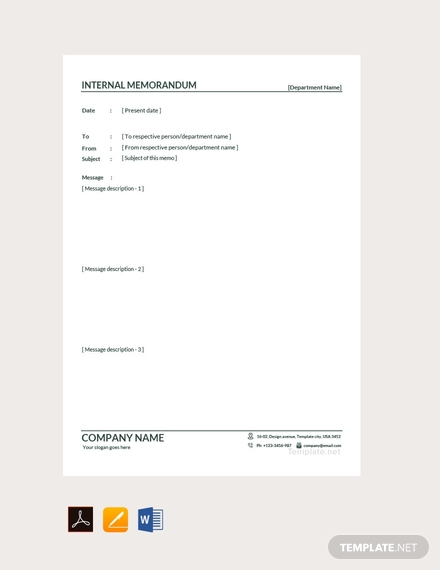
Blank Internal Memo

How to Make a Memo
Remember that memos are used to convey important information, that’s why it is important that it is made keenly and effectively. You need to make sure that you provide sufficient and correct information to ensure that the readers can understand what the memo is trying to convey. Here is a short and easy guide you can follow to make sure you make a good memo:
1. Write memo title: As mentioned, the title of the memo should be on the center of the topmost part of the paper. You should use a clear and bold font style so that it is easily readable. For example, the memo title Business Memo should be clearly written on top of the page so that the reader can easily read what and understand that the contents are about formal and important business matters.
2. Indicate heading: Below the title, you should immediately provide information for the To, CC, From, Data, Subject sections. Remember to provide accurate information for each section since the accuracy of where it is delivered and who gets to read it depends on those information. Aside from that, the effectiveness of the memo will also be affected with what information you indicate in the aforementioned sections.
3. Write clear opening: When writing the memo it is important to clearly but briefly write its opening. Remember that the opening will set the tone for the entire memo that’s why its important that you provide enough context with regards to the subject. Providing a clear opening that explains the urgency or importance of the matter will help the readers to understand and act accordingly. You need to provide sufficient accurate details and break down the subject into easily understandable sections, if necessary.
4. Provide sufficient supporting information: Once you have clearly provided an opening for the memo, make sure that you also include enough supporting details that will explain the subject you are addressing in a more comprehensible manner. Make sure that analyses, facts, statistics, and so on are provided. Depending on the complexity of the matter being addressed, it may be necessary to provide a summary after each topic is discussed. You may also see formal memo.
5. Professionally close the memo: After you have distinctly explained all the details with regards to the subject, make sure that you professionally close the memo. You also need to provide the necessary actions that those concerned must do and explain how those actions can be of the greater good. If there are any documents attached to the memo, make sure to indicate that in the end part of the memo.
Tips in Writing a Memo
Now that you have an idea on how make a memo, you can easily make it should you be tasked to do so. However, if you still find it difficult to do so, here are some tips and tricks that you can refer to when writing a memo:
- Make a draft/outline of the memo before writing a final draft.
- Use a memo template for more efficiency.
- Regardless of brevity or complexity of the subject, maintain coherence of all the contents.
- Be direct and straightforward.
- Aim to make the memo as brief as possible.
- Do not use words that are too technical especially when the memo is for everyone and not just an interoffice memo.
- Provide as much supporting data and detail as needed.
- Use bold fonts or highlighting to emphasize important words or phrases.
- Proofread and edit accordingly before publishing or distributing.
Types of Memo
A memo can contain a wide range of topics it can be specifically tailored to the purpose it will be used for. This means there are also quite a few types of memos that you can use. Hence, here are some of the types memo that you can use within or outside the office:
- Request memo: This memo is used when you want to request something from someone. It should be written in a convincing manner since its main goal it to get a positive response or action from the reader; use persuasive words but still maintain professionalism regardless of the depth of the relationship between you, the writer, and the recipient. You may also see management memo examples.
- Confirmation memo: To officially confirm a verbal agreement between two or more people or companies, a confirmation memo is made. It makes the agreement official with the agreed terms and conditions stated, and with the signature of those involved.
- Ideas and suggestions memo: This memo can be used when there is a need to elicit or submit ideas and suggestions about a certain subject. This ensures that everyone has knowledge about the need of ideas and suggestions about the subject.You may also see internal memo examples.
- Periodic report memo: Most of the time, this memo is used as an update about ongoing projects. Periodically this memo is distributed to report what progress and developments have been made. This helps everyone stay on the loop and updated about certain matters that concern them.
- Informal study results memo: A study results memo is used to present the results of an informal study. A detailed explanation and presentation of the results during the study. However, the details are presented in easily comprehensible manner to ensure everyone easily understands the findings.
13+ Memo in Google Docs Examples
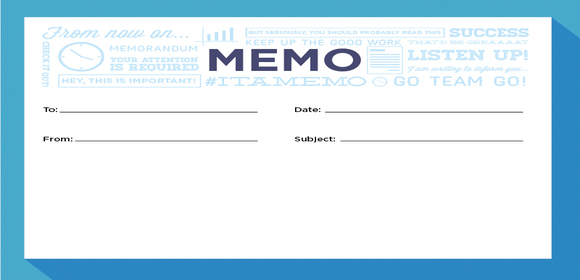
In order to make sure that everyone in the company can retain the information that has been discussed or to give them the information that they should know about, a unified method of communication should be used. This will greatly help in maintaining harmony and peace within the company since information is shared transparently and succinctly.
With this regard, a memo or memorandum is document used to communicate policies, procedures, or related official business. It also helps those in charge in the company or organization to impose rules and policies within their jurisdiction. And since it expresses the finality in the decisions, it also encourages those concerned for their total compliance.
Elements of a Memo
Since a memo is a formal or official document used to share information to those concerned, it should be detailed and complete. To help you create a good and effective memo, here are the essential elements that you should include:
1. Title: On the topmost part of the memo it should indicate a title describing what it is for or what the contents are about. For example, when you the indicated memo title is Meeting Minutes Memo it tells the reader that the contents he/she is about to read has everything to do with the minutes of a meeting.
2. Heading: The heading of the memo contains all pertinent information about who it is from and who it is for. It should provide information about the following:
To: Name/s who the memo is intended for; who are those concerned with the memo
Cc: Name of who gets a copy of the memo
From: Complete name, position or designation, office or department of the writer
Date: Date when the memo is written
Subject: Gist of the memo
4. Opening: The opening should provide more context with regards to the subject being discussed. It should briefly explain the purpose why there was a need to write and distribute the memo. A complete overview about the event, circumstance, or background of the problem.
5. Body: The body of the memo should provide supporting details with what has been explained in the opening. You should provide supporting details such as facts, statistics, hypotheses, and so on. If necessary, you can also provide charts, graphs, and other illustrations so that there is a clear representation of the data and information you are conveying.
6. Summary: You need to make sure that your readers are able to understand all the information you have discussed in the memo; therefore, you should provide a clear summary. The summary should be able to briefly explain what has been discussed in the previous parts of the memo; only focus in discussing the most important topic.
7. Closing: The closing should provide a call to action as to encourage everyone to their responsibilities or parts in solving the issues or problems. You should also specify how those actions can be of benefit for everyone. You may also see student memo.
13+ Memo Templates
Sample Memo Example

Template Details
Size: A4, US
Audit Memo Example

Template Details
Size: A4, US
Internal Audit Memo Example

Template Details
Size: A4, US
Meeting Memo

Template Details
Size: A4, US
Staff Meeting Memo

Template Details
Size: A4, US
Internal Memo to Employees

Template Details
Size: A4, US
Internal Memo Template

Template Details
Size: A4, US
Business Meeting Memo

Template Details
Size: A4, US
Blank Meeting Memo

Template Details
Size: A4, US
Board Meeting Memo

Template Details
Size: A4, US
Formal Internal Memo

Template Details
Size: A4, US
Debit Memo Template

Template Details
Size: A4, US
Internal Memo Format

Template Details
Size: A4, US
Blank Internal Memo

Template Details
Size: A4, US
How to Make a Memo
Remember that memos are used to convey important information, that’s why it is important that it is made keenly and effectively. You need to make sure that you provide sufficient and correct information to ensure that the readers can understand what the memo is trying to convey. Here is a short and easy guide you can follow to make sure you make a good memo:
1. Write memo title: As mentioned, the title of the memo should be on the center of the topmost part of the paper. You should use a clear and bold font style so that it is easily readable. For example, the memo title Business Memo should be clearly written on top of the page so that the reader can easily read what and understand that the contents are about formal and important business matters.
2. Indicate heading: Below the title, you should immediately provide information for the To, CC, From, Data, Subject sections. Remember to provide accurate information for each section since the accuracy of where it is delivered and who gets to read it depends on those information. Aside from that, the effectiveness of the memo will also be affected with what information you indicate in the aforementioned sections.
3. Write clear opening: When writing the memo it is important to clearly but briefly write its opening. Remember that the opening will set the tone for the entire memo that’s why its important that you provide enough context with regards to the subject. Providing a clear opening that explains the urgency or importance of the matter will help the readers to understand and act accordingly. You need to provide sufficient accurate details and break down the subject into easily understandable sections, if necessary.
4. Provide sufficient supporting information: Once you have clearly provided an opening for the memo, make sure that you also include enough supporting details that will explain the subject you are addressing in a more comprehensible manner. Make sure that analyses, facts, statistics, and so on are provided. Depending on the complexity of the matter being addressed, it may be necessary to provide a summary after each topic is discussed. You may also see formal memo.
5. Professionally close the memo: After you have distinctly explained all the details with regards to the subject, make sure that you professionally close the memo. You also need to provide the necessary actions that those concerned must do and explain how those actions can be of the greater good. If there are any documents attached to the memo, make sure to indicate that in the end part of the memo.
Tips in Writing a Memo
Now that you have an idea on how make a memo, you can easily make it should you be tasked to do so. However, if you still find it difficult to do so, here are some tips and tricks that you can refer to when writing a memo:
Make a draft/outline of the memo before writing a final draft.
Use a memo template for more efficiency.
Regardless of brevity or complexity of the subject, maintain coherence of all the contents.
Be direct and straightforward.
Aim to make the memo as brief as possible.
Do not use words that are too technical especially when the memo is for everyone and not just an interoffice memo.
Provide as much supporting data and detail as needed.
Use bold fonts or highlighting to emphasize important words or phrases.
Proofread and edit accordingly before publishing or distributing.
Types of Memo
A memo can contain a wide range of topics it can be specifically tailored to the purpose it will be used for. This means there are also quite a few types of memos that you can use. Hence, here are some of the types memo that you can use within or outside the office:
Request memo: This memo is used when you want to request something from someone. It should be written in a convincing manner since its main goal it to get a positive response or action from the reader; use persuasive words but still maintain professionalism regardless of the depth of the relationship between you, the writer, and the recipient. You may also see management memo examples.
Confirmation memo: To officially confirm a verbal agreement between two or more people or companies, a confirmation memo is made. It makes the agreement official with the agreed terms and conditions stated, and with the signature of those involved.
Ideas and suggestions memo: This memo can be used when there is a need to elicit or submit ideas and suggestions about a certain subject. This ensures that everyone has knowledge about the need of ideas and suggestions about the subject.You may also see internal memo examples.
Periodic report memo: Most of the time, this memo is used as an update about ongoing projects. Periodically this memo is distributed to report what progress and developments have been made. This helps everyone stay on the loop and updated about certain matters that concern them.
Informal study results memo: A study results memo is used to present the results of an informal study. A detailed explanation and presentation of the results during the study. However, the details are presented in easily comprehensible manner to ensure everyone easily understands the findings.

